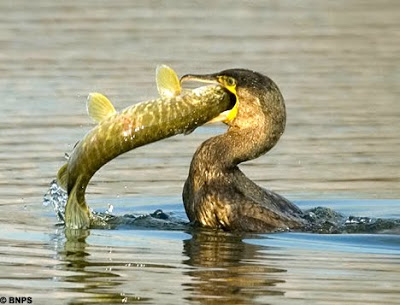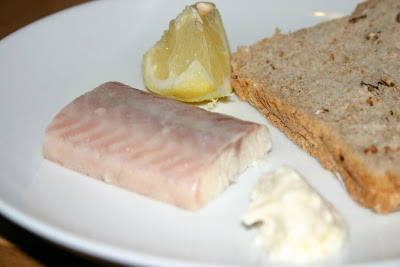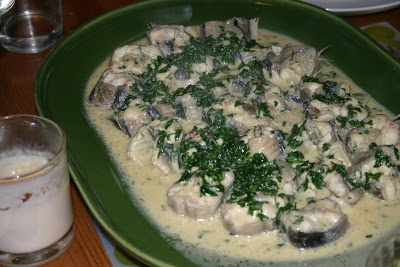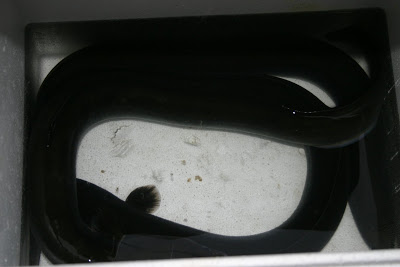Tag: freshwater fish
#328 Salmon in Pastry, with a Herb Sauce
This is a recipe that is inspired by the medieval love of combining fish and candied sweetmeats. Griggers says it is a ‘brave, but entirely successful blend’. We’ll see. Large medieval banquets had to contain dishes with lots of spice; after all how else could you display your vast wealth other than to use that new and exciting new spice, sugar? When first brought to Europe from India, sugar was considered a spice like any other and therefore medicinal. It lost its rank as a spice once it gained popularity as a more general addition to the dinner table; albeit a giant banqueting table.
Whilst the salmon cooks, you can get on with the sauce. Gently fry 2 chopped shallots, a heaped teaspoon of chopped parsley and a teaspoon of mixed chopped tarragon and chervil in 2 ounces of butter. When the shallots have softened, stir in a teaspoon of flour, then ½ pint of single cream (or half single-half double; American readers: heavy whipping cream is the thing to use here). Simmer for around 10 minutes, then season with salt and pepper and a teaspoon of Dijon mustard. Whisk 2 egg yolks with a couple more tablespoons of cream, turn down the heat in the pan and pour in. The sauce will thicken as the yolks start to cook – do not let the sauce boil, or your yolks will scramble. Finally, lift the whole thing by adding a good squeeze of lemon juice.
#323 Salmi of Game (or Duck, or Fish)
A salmi, also known as salmis, salomine and salomene is essentially a posh game stew and is an abbreviation of salmagundi which started life in France as a meat ragoût. A salmi, rather than being any meat, should be made using game birds that are partly-cooked, and then finished off in a rich sauce made from their bones, though domesticated birds like capon and Guinea fowl are commonly used. Jane Grigson complains that more often than not, salmi is made from leftover game meat and then offered at high prices in high-end restaurants. ‘Don’t be deceived’, she says, ‘[i]t is exactly what would have been eaten by Chaucer, or his son, at the court of Henry IV, or by that granddaughter of his, Alice, Duchess of Suffolk, at her manor at Ewelme.’ Grigson mentions the food eaten at the court of Henry IV a few times in English Food: giving recipes for quince comfits and ‘a coronation doucet’.
Cubebs are a type of pepper (latin name: Piper cubeba) that you can still buy from specialists, gilliflowers are a very fragrant species of carnation and ‘powder’ refers to a mixture of ground spices.
Roast your game birds rare, cut the meat from the carcass into neat ‘gobbets’.
Use the carcasses to make ¾ pint of game stock. Melt 2 ounces of butter in a pan and cook 3 chopped shallots until soft and golden. Now stir in a heaped tablespoon of flour and whisk in the hot stock a third at a time to prevent lumps forming.
Add a bouquet garni and a pared strip of orange peel (Seville oranges would be great if you can get them) and simmer for 20 minutes, to make a thick sauce. Pass the sauce through a sieve and add ¼ pint of red or white wine and 4 ounces of mushrooms that have been fried in butter. Season with salt, pepper and lemon juice. Simmer for a further 5 minutes, then add the game and simmer very gently again for 10 more minutes. Add a little cayenne pepper. Serve with orange wedges and croûtons fried in butter.
#313 Jellied Eel Mousse with Watercress Sauce
This is one of the recipes that when I started this project, really made me shudder. However, as I have cooked a couple of eel recipes, I have discovered that I quite like the slippery critter and it no longer seemed such a challenge. Plus all of the weird recipes thus far have turned out pretty good and I have lost all squeamishness; I have a philosophy that in rich countries people eat things because they taste good, not because they need to simply survive.
If you wanted to buy jellied eels in London, you would have had to go to an Eel Pie and Mash House. There not many around – they declined in number from over a hundred after the Second World War to just a handful today. The most famous – and London’s oldest – extant Eel and Pie House is Manze’s in Peckham. I have never been to one of these places, but I shall try my best to frequent Manze’s next time I pop down to London. I doubt if they will ever regain popularity, even though eels have now returned to the River Thames.
This is an ‘updated’ recipe from chef Guy Mouilleron, who apparently thought of an eel slithering through a bank of watercress and thought the two might might together. The recipe is outdated; fish mousses are certainly a thing of the 1970s and 1980s; when English Food was first published.
To make the mousse, you need to prepare your eels. You’ll need around 2 ½ pounds of eel altogether. If you can get the fishmonger to skin and fillet them for you, all’s the better. I didn’t have such a luxury, but found it quite easy now that I have had certain amount of experience with eel preparation. First of all, give them a wash and wipe away any slime that may remain on the skin. To skin an eel, you first need to cut through the skin all around its neck, behind the gills. Next, either nail the head to a wooden chopping board or grasp the head with a tea-towel. Now you need to pull on the cut skin and peel the skin off like a stocking. It is quite difficult to get a purchase, so sprinkle the neck liberally with salt to create some much-needed friction. Once skinned, it is pretty easy going after that; gut it, cutting from the head-end to an inch or so past the vent so that the kidneys as well as the other internal organs can be removed. Filleting was a bit tricky – but really it was just like filleting any fish really. Use a sharp knife and cut from the head end to the tail end, pressing down on the fish with your other hand, which creates pressure and makes the cut much easier to make.
Cover the terrine or tin with a double-layer of foil and then steam it for 1 ¼ hours. I used a fish kettle for this, but if you don’t have something appropriate, you can pop it in a roasting tin containing boiling water and bake it at 160-180⁰C (325-350⁰F). When cold, put it in the fridge overnight.
The next day, make the sauce. You need a good-sized bunch of watercress. From the bunch, pick and reserve enough leaves to make around a tablespoon when chopped. The rest, liquidise in the blender, using the smallest amount of water possible. Pass the watercress slurry through a sieve and add ¼ pint of double cream and whisk it until it thickens. Season and stir through the reserved, chopped leaves. Serve a slice of the mousse with a generous spoonful of the sauce.
#313 Jellied Eel Mousse with Watercress Sauce. My God, what a sight that one was! It looked like a massive chunk of cat food and the sauce was so garish. The taste of the mousse wasn’t too bad, but the texture seemed so wrong. If it had been eaten warm as a creamy stew, it probably would have been delicious. The mild fish and the grassy watercress did not go together in my opinion. A big shame because was waiting to be surprised by its loveliness. I think I would have been happier with some proper jellied eels. Keep the fish mousse where it belongs: in the past! 2/10
#251 Fried Eel with Fried Parsley
Anyway, enough of my rantings here is the recipe:
This recipe serves four people.
First, you need to prepare your eel; a two-pounder is required here. It needs to be skinned and then cut into three inch pieces. If it has been portioned already, but not skinned, you can either leave it on or fry the pieces skin-side-down in very hot oil for a few seconds. This makes the skin easy to peel off without cooking the eel itself. Next, coat the eel in seasoned flour and fry gently in 4 ounces of clarified butter until browned and the meat comes away from the bones easily. This took me about 7 minutes, but this will depend upon thickness. Next, prepare a lemon-butter sauce by melting 6 ounces of slightly salted butter in a saucepan and adding lemon juice to taste (I used a whole one). Put the eel onto a serving dish and keep warm. Now fry the parsley stalks. Start by heating up oil in a saucepan and fry around 12 parsley sprigs for a few seconds until crisp. Be careful here: the oil will splatter so just fry 3 or 4 at a time. Serve with some lemon-butter sauce poured over the eel, with extra in a jug, and the parsley sprinkled over it.

#251 Fried Eel with Fried Parsley. I have to admit, eel is a tasty fish and cooked this way really shows off it mild, yet delicious flavour. The fried parsley too was very good; like a grassy version of crispy seaweed you get from the Chinese take away! The only problem was the lemon butter – it just made the eel taste greasy. I think tastes have changed somewhat these days, and I think that a lemon mayonnaise would suit it better. However, still a pretty good recipe. 7.5/10.
#246 Pike
The Freshwater Fish chapter of English Food has been the most difficult part of the book to source ingredients for. You can’t just walk into a fishmonger and ask for a fillet of pike or whatever. Fish are sold by the crate and no-one eats enough these days for it to be worth the fishmonger buying it, salmon and trout excepted. It’s probably not a bad idea – the fish in our rivers and lakes seem so finite compared to sea fish, so if folks got a taste for them they would be fished into extinction. That said, there are shit-loads of pike in our rivers, so why not pop down to one and fish one of the buggers out.

Who would have thought pike vs. cormorant would have turned out like this?
Jane Grigson was a fan of pike, as were the French who used to farm the scary fanged fish. Actually they’re quite beautiful with their green tiger stripes. I got two fine fillets from The Fish Society, and I suggest you have a look there if you fancy having a go at trying pike, or any other difficult-to-get-hold-of fish. This is what Griggers reckons you should do with it:
Fillet the fish and remove the pin bones (of which there are many) before marinating in some sherry and Madeira wine. After an hour or so, drain the fillets and coat them in seasoned flour and fry in oil and butter until golden and crisp. Serve with a lightly-curried velouté flavoured with the marinade juices. I used, half an ounces each of flour and butter for the roux and then half a pint of fish stock plus half a teaspoon of mild curry powder. Add some cream too if you like.

#246 Pike. This was really delicious – a firm, meaty and mildly sweet fish. Also, it wasn’t in the least ‘muddy’ tasting as we keep getting told freshwater fish tastes like. I would definitely recommend this if you can get hold of it. The sauce was pretty good too. If you see it in a restaurant, order it. 7.5/10
#234 Smoked Eel
There are a few smokehouses that smoke eels in Britain, though the eels themselves are usually brought over from Holland and the surrounding countries due to the fact that are fewer of the beasties to found in British rivers.

This is not a recipe, but really a suggestion by Griggers as to the best way to appreciate smoked eel. As a starter, give each person a three inch section of eel fillet along with some good brown or rye bread and butter, a lemon wedge and perhaps some horseradish sauce. That’s it. Enjoy.
#234 Smoked Eel. A true delicacy; and the best way to treat a delicacy is to eat it in the simplest way possible. The flesh was sweet, succulent and firm, not the soft and slightly gelatinous consistency of smoked salmon which I can find rather off-putting. Don’t be squeamish and get it down yer. Fab stuff 8/10.
#197 Sedgemoor Eel Stew
The first of four eel-based recipes from the book (five if you include the elvers recipe) and hopefully the star turn for my dinner party. I chose this one first because I knew them some people would be squeamish about them and this one seemed the least scary. It’s called a stew, but really it’s poached fish in a parsley sauce; a dish that everyone’s had in some way or form before. It’s a classic Somerset recipe this, where there are eels in abundance (according to Griggers); this is not the case so much these days, certainly for Manchester. However, I did get them. Try your fishmonger and you never know; I got mine from Out of the Blue in Chorlton. Be warned – you do get them live, so be prepared to kill them and prepare them yourself. Read how I went about it here.
This serves six easily.
You need three to four pounds of clean and skinned freshwater eel for this recipe. Begin by cutting the eel(s) into even-sized portions of around two inches in length. Season them lightly. Make a stock from the eel heads and skin as well as the flat part of the tails: Place the trimmings in a pan and cover them with half-water, half-cider (use good dry cider). Bring to a boil and then cover and summer for twenty minutes.
Arrange the eel pieces in a shallow pan and pour over enough hot stock to barely cover the eels. Poach the eels for around fifteen minutes, until the eel meat starts to come away from the bones. Don’t let the stock come to a proper boil though – steady poaching is the key, and it may take longer with thicker eels. When cooked, remove the eel pieces and arrange them on a serving dish, cover them with cling film and keep them warm.
Now make the sauce by boiling down the cooking liquor until it tastes strongly and then add ¼ pint (i.e. a 150 ml pot) of clotted, Jersey or double cream and four tablespoons of chopped parsley. Season again if required. Pour the sauce over the eel and serve. She suggests serving this stew with toast or fried bread. As fried bread had already featured in the last two courses, I went for toast. I also served some broccoli too.
#197 Sedgemoor Eel Stew. This was really good; the sauce was both sharp and creamy due to the cider and fresh with grassy parsley. The flavours were robust, but not too strong to mask the eel itself. It was very delicate in flavour; you could tell that they had come from a very good river as it tasted of fresh springwater. It stayed beautifully moist due to the gelatinous nature of it too. Much superior to salmon or trout, I think. Now that people don’t eat eel, I feel I have found a real hidden gem. I just have to go through the rigmarole of killing and cleaning them! At least I can say that this was the freshest fish I’ve ever had! 8.5/10
FYI: delicious as eel maybe, beware if someone offers you raw eel, say as sashimi. Eel blood is toxic before it is cooked, so if you get given a bloody bit, it could be a bad man trying to do away with you.
…Next, Simply Prepare Your Eels
So how do you kill and prepare an eel? Well, if you look in English Food, Griggers just says to ask your fishmonger to do the dirty work. The was not to be the case for me, for two main reasons: my fishmonger (and pretty much any fishmonger in the country, I hasten to add) had never dealt with them at all. Remember: fishmongers do not receive live fish, apart from the odd lobster or crab perhaps, so this was just as out of his comfort zone as mine. The second reason was that I felt it part of my duty as a meat-eater to do this. Every animal we have eaten has had to be killed. These days, however, the consumer hardly ever does this themselves. We are too far removed from our food these days and therefore disrespectful of it so some degree. This is a way of addressing this issue for me. I did not expect to find it easy. In fact I was very nervous; I had never killed anything in my life and I was not looking forward to it. I didn’t want it to be easy; I wanted it to be distressing (for me, not the eels). We take all this animal killing in our stride.

I have gone off on a tangent. Larousse Gastronomique gives you these instructions on how to prepare an eel. It sounded all so easy:
“To kill an eel, simply seize it with a cloth and simply bang its head violently against a hard surface. To skin it, simply put a noose around the base and hang it up. Simply slit the skin in a circle just beneath the noose. Simply pull away a small portion of the skin, turn it back, take hold of it with a cloth and simply pull it down hard.”
I added the “simply”s. Well it didn’t quite go like the description in Larousse. So here’s what we ended up doing:
First up, you need to have a couple of rums to help prepare you. That’s what Paul and I did and I think it helped. We fannied around a bit before Charlotte walked in from work, grabbed one in a cloth and gave it several massive thwacks again the wall. Job a good one? No. It was still alive! She gave it another couple and it went limp. This was not like killing a trout with a short, sharp crack on a stone. We felt quite distressed about the several hits that we had to give it to kill it – we didn’t want to cause any unnecessary suffering. So the new plan was to hit it once to knock the others out or slow them down, and then chop the heads off with a meat-cleaver. I know this might sound extreme but, it seemed like the best thing – plus I remember it being the method I remember seeing some chef doing on telly once. We did it, and guess what? They were still moving about! I took the two now headless eels to the, plus Charlotte’s to the skin to rinse, and revived Charlotte’s. Off with its head.
Before you get angry about any mistreatment here – it turns out that they were all dead quite early on. We worked this out because all three eel bodies were still seemingly happily snaking around in the sink a good 45 minutes post-beheading. It seems that much of their behaviour is down to instinct and their autonomic nervous system. Though I’ve no idea how this happens and why it’s so different to other fishes. Below is the rather gruesome video of the headless eels I took when they were in the sink. I mentioned the whole episode to Matthew Cobb (who I work with at Manchester University) who said he’ll put a link to this post on his z-letter. (FYI: The z-letter is weekly newsletter about all things zoological.) Hopefully I shall find out why they just don’t conk out. Be warned before clicking on the video if you are squeamish, remember too though that they are dead. Also, I apologise for my rather camp commentary. Let me know if you can tell me anything about eels and their habit of moving and swimming long after death.
The next stage of preparation is to skin them. In our panic, thinking we hadn’t killed eels when we had, we cut off the heads so couldn’t do the noose trick outlined in Larousse. Instead, we tried to make slit down the base and peel the skin away some other way. Anthea had arrived by this point, to find us sweating, giggling and holding bloody carving knives, and she suggested using some salt as it would give grip against their very slimy skins. At first all this seemed to do was kick-start the wriggle reflex again, but eventually – with Anthea restraining the wriggling eel with yet more cloths – I managed to get a purchase on the eel and pull the skin off in one piece. Just two more to go.
The hard work was done, just the gutting to do. At last I was on familiar territory. I’ve gutted fish several times before. To do this, make a cut from its anus – you’ll see it, about halfway down – to the neck end and pull away any innards away from the rib cage. Give it a rinse and you are done.
Well I have to say it was a pretty distressing episode, it wasn’t as bad as we thought at the time. I now know that eels carry on a-moving quite a while after death. So, to sum up:
1. Holding a cloth, hit your eel several times very hard against a wall.
2. Whilst the eel is limp, quickly cut off its head with a cleaver or very sharp knife.
3. Using salt as an abrasive, pull the skin back – persevere here – until you have a good inch of skin eked away, then pull off like a big macabre witch stocking.
4. Gut and wash the eel.
It sounds so easy put into four sentences.
First, Catch Your Eels…
There are four eel recipes in English Food: fried eel, jellied eel, eel stew and eel pie. If I’ve any chance of cooking all the recipes in English Food, I realised that I really need to start sourcing the more unusual ingredients. I also needed to source people prepared to eat them. Eels were once very popular, particularly in South-Western England and London. They aren’t so much these days for two reasons – people are scared of eels, and the baby eel (elver) population has crashed, causing some concerns of the future of the European eel. I‘ve discussed the elver issue in an earlier post. The adult population has gone down as a knock-on effect, but not to dangerous levels. It is a shame that people don’t want to eat them as they are tasty, but it is probably a good thing for their population. There’s is nothing wrong with fishing for then in small numbers however.
Before preparing and cooking your eel, you have to get hold of some from somewhere, no mean feat, not for you, but for the poor fishmonger you talk into getting them for you.

Whilst shopping in Manchester, I popped into the Arndale Market to see if there was anything interesting on the off chance. There wasn’t, but I thought I’d enquire about eels. He said there’d be no problems, he just needed a bit of notice, so off I went and organised a dinner party and invited people round. When I rang up, the guy who answered said “sorry mate, but I’ve not seen eels for years, there’s no chance”. Oh dear. It seems that eel would be off the menu completely.
I didn’t give in, and as soon as I got to work, I rang the one place that I knew would find out for sure if eels are still available: Out of the Blue in Chorlton. Out of the Blue is a great fishmonger, and has won many an award. I used to use them all the time when I lived there. After a bit of detective work from their end, I got a phone call back a few days later and as if by magic, Dave Yarwood, the owner said he’s managed to get hold of some for me and they’d be ready by the Friday. Also – something I didn’t realise, you get them live. I knew the fishmonger would probably get them live, but I didn’t know I’d have to do away with them myself.
Feeling rather nervous throughout the week, it was finally Friday and off I went to Chorlton full of trepidation. In the shop, Dave asked me to come behind the counter where there they were – three freshwater eels swimming around in a big water-filled box. I remained as calm outside; inside, I was bricking it. What the hell!? I’m going to have to do away with three eels. I’ve never killed anything in my life, houseflies aside. I’d like to point out that Dave Yarwood is a total star for this – the amount of effort he put into getting hold of these eels for outweighed the effort I put in prepping or cooking them. He had to drive all the way to Sandbach at some god-awful time in the morning only to get there to find no one around. He did find a note on the door saying the eels were in a bag in the stream round the back!























